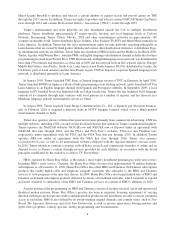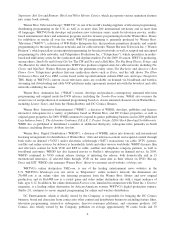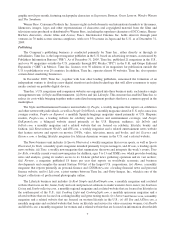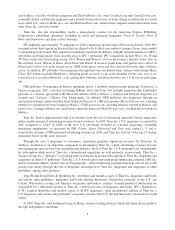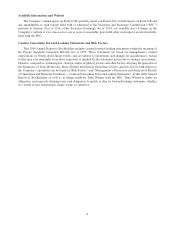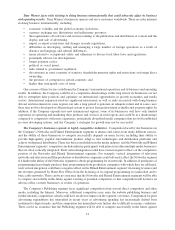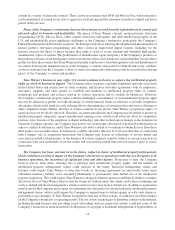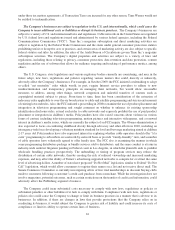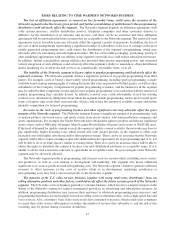Time Magazine 2009 Annual Report Download - page 22
Download and view the complete annual report
Please find page 22 of the 2009 Time Magazine annual report below. You can navigate through the pages in the report by either clicking on the pages listed below, or by using the keyword search tool below to find specific information within the annual report.RISK FACTORS
RISKS RELATING TO TIME WARNER GENERALLY
The Company must respond to recent and future changes in technology, services and standards and changes
in consumer behavior to remain competitive and continue to increase its revenues. Technology, particularly
digital technology used in the entertainment industry, continues to evolve rapidly, and advances in that technology
have led to alternative methods for the delivery and storage of digital content. These technological changes have
driven and reinforced changes in consumer behavior, as consumers increasingly seek control over when, where and
how they consume digital content. For example, content owners are increasingly delivering their content directly to
consumers over the Internet, often without charge, and consumer electronics innovations have enabled consumers
to view such Internet-delivered content on televisions and portable devices. Further, the current economic
conditions could have the effect of accelerating the migration to digital technologies among both providers and
consumers of content, with companies seeking greater efficiencies and consumers seeking more value and lower
cost alternatives.
Technological developments also pose other challenges for the Company that could adversely affect its
revenues and competitive position. For example, the Company may not have the right, and may not be able to secure
the right, to distribute its licensed content across new delivery platforms that are developed. In addition,
technological developments that enable third-party owners of programming to bypass traditional cable
networks, such as the Turner Networks and the Home Box Office Services, and deal directly with cable
system and other content distributors could place limitations on the ability of the Networks and Filmed
Entertainment segments to distribute such third-party programming that could have an adverse impact on their
revenues. Cable system and direct broadcast satellite operators are increasingly able to transmit more channels on
their existing equipment, reducing the cost of creating channels and potentially furthering the development of more
specialized niche audiences, which could increase the competition for viewers. Furthermore, advances in
technology or changes in competitors’ product and service offerings may require the Company in the future to
make additional research and development expenditures or to offer at no additional charge or at a lower price certain
products and services that are currently offered to customers separately or at a premium. There is also the risk that
the Company could develop or support a new technology or business initiative that is not adopted by consumers. In
addition, traditional audience measures have evolved with emerging technologies that can measure audiences with
improved sensitivity, and there may be future technical and marketplace developments that will result in new
audience measurements that may be used as the basis for the pricing and guaranteeing of the advertising contracts of
the Publishing segment or the advertising-supported networks in the Networks segment, which could have an
adverse effect on these segments’ advertising revenues and an indirect adverse impact on the Filmed Entertainment
segment’s licensing revenues. There is also the risk for the Publishing segment that new delivery platforms could
lead to pricing restrictions, the loss of distribution control and the loss of a direct relationship with consumers.
The Company’s failure to protect and maximize the value of its content, while adapting to, supporting and
developing new technology and business models to take advantage of new and emerging technologies and changes
to consumer behavior could have a significant adverse effect on the Company’s businesses and results of operations.
The introduction and increased popularity of alternative technologies for the distribution of entertainment,
news and other information and the resulting shift in consumer habits and advertising expenditures from
traditional media to digital media could adversely affect the Company’s revenues. The Company’s Publishing
and Networks segments derive a substantial portion of their revenues from advertising in magazines and on
television, respectively. Distribution of entertainment, news and other information via the Internet has become
increasingly popular over the past several years, and viewing entertainment, news and other content on a personal
computer, mobile phone or other electronic or portable electronic device has become increasingly popular as well.
Accordingly, advertising dollars have started to shift from traditional media to digital media. The Company believes
that the shift in major advertisers’ expenditures from traditional media to digital media has adversely affected the
revenue growth of the Publishing and Networks segments, which may continue in the future. This shift could further
intensify competition for advertising in traditional media, which could exert greater pressure on these segments to
increase revenues from digital advertising. In addition, if consumers increasingly elect to obtain news and
entertainment online instead of by purchasing the Publishing segment’s magazines, this trend could negatively
10






